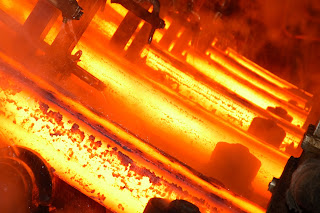 |
| Industrial steam turbines can be negatively impacted by silica |
To conclude the three part series on water quality analysis in process control related industrial applications we examine silica, another element which in sufficient quantities can become a confounding variable in water for industrial use. In natural settings, silica, or silicon dioxide, is a plentiful compound. Its presence in water provides a basis for some corrosion-inhibiting products, as well as conditioners and detergents. Problems arise, however, when high concentrates of silica complicate industrial processes which are not designed to accommodate elevated levels. Specifically, silica is capable of disrupting processes related to boilers and turbines. In environments involving high temperature, elevated pressure, or both, silica can form crystalline deposits on machinery surfaces. This inhibits the operation of turbines and also interferes with heat transfer. These deposits can result in many complications, ranging through process disruption, decreased efficiency, and resources being expended for repairs.
The silica content in water used in potentially affected processes needs to be sufficiently low in order to maintain rated function and performance. Silica analyzers provide continuous measurement and monitoring of silica levels. The analyzers detect and allow mitigation of silica in the initial stages of raw material acquisition or introduction to prevent undue disruption of the process. Additionally, a technique called power steam quality monitoring allows for the aforementioned turbine-specific inhibition – related to silica conglomerates reducing efficacy and physical movement – to be curtailed without much issue. The feedwater filtration couples with a low maintenance requirement, resulting in reduced downtime of analytic sequences and a bit of increased peace of mind for the technical operator.
While silica and the other compounds mentioned in this series are naturally occurring, the support systems in place to expertly control the quality of water is the most basic requirement for harvesting one of the earth’s most precious resources for use. As a matter of fact, the identification and control of compounds in water – both entering the industrial process and exiting the industrial process – demonstrates key tenets of process control fundamentals: precision, accuracy, durability, and technological excellence paired with ingenuity to create the best outcome not just one time, but each time.
The measurement of the various contaminating constituents of process water requires special equipment and techniques. Share your water quality measurement requirements and challenges with fluid process specialists, combining your own knowledge and experience with their product application expertise to develop effective solutions.
While silica and the other compounds mentioned in this series are naturally occurring, the support systems in place to expertly control the quality of water is the most basic requirement for harvesting one of the earth’s most precious resources for use. As a matter of fact, the identification and control of compounds in water – both entering the industrial process and exiting the industrial process – demonstrates key tenets of process control fundamentals: precision, accuracy, durability, and technological excellence paired with ingenuity to create the best outcome not just one time, but each time.
The measurement of the various contaminating constituents of process water requires special equipment and techniques. Share your water quality measurement requirements and challenges with fluid process specialists, combining your own knowledge and experience with their product application expertise to develop effective solutions.



